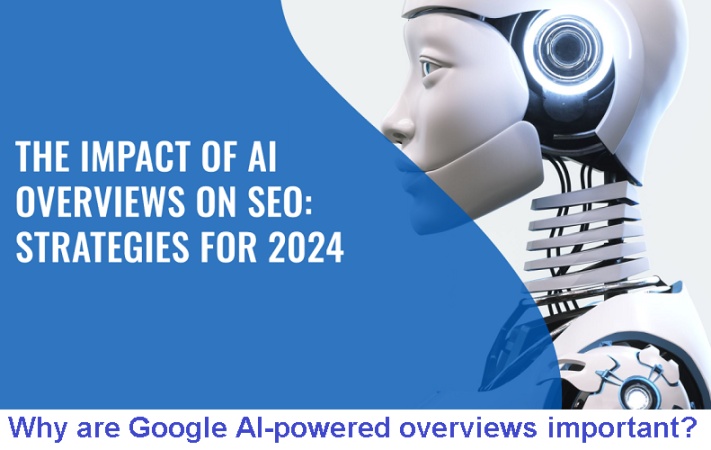

AI overviews are compilations or thorough manuals that provide a general understanding of artificial intelligence (AI). These overviews typically cover the following topics:
1. Definition and scope:
Basis definitions of artificial intelligence.
Various branches and forms of artificial intelligence exist (including artificial superintelligence, general artificial intelligence, and restricted artificial intelligence).
2. Origin and Development: History
There have been significant milestones in the development of artificial intelligence.
Notable people and field pioneers.
3. Fundamental ideas and methodologies:
Machine learning; deep learning; neural networks; natural language processing; computer vision; robots.
Algorithms and approaches applied in artificial intelligence include generative models, unsupervised learning, reinforcement learning, and supervised learning.
4. Purposes and Use Cases:
Practical uses of artificial intelligence exist in several sectors, including cybersecurity, automobiles, entertainment, finance, and healthcare.
Common artificial intelligence technologies found in daily life include virtual assistants, recommendation systems, and driverless cars.
5. Ethical and social implications:
The article discusses the ethical issues of artificial intelligence, including privacy, prejudice, responsibility, and its effects on employment and society.
AI-related governance and regulatory concerns.

6. Current Directions and Future Trends:
Research and application of artificial intelligence are developing patterns.
The article provides forecasts and conjectures on the direction of artificial intelligence.
7. Difficulties and constraints:
Technical difficulties advancing artificial intelligence.
The conventions of current artificial intelligence systems and potential solutions are discussed.
Covering theoretical knowledge, practical applications, and more general consequences, these overviews seek to give a complete picture of artificial intelligence for beginners and expert students.
Google's AI-powered overviews are valuable for a number of reasons.
1. Improved search experience:
AI can understand the background of search queries, resulting in more relevant and complete responses.
Quick information retrieval provides users with accurate and succinct summaries, saving time and effort in locating data.
2. Enhanced relevancy and accuracy:
Google's artificial intelligence systems can process enormous volumes of data, therefore guaranteeing that the material offered is accurate and current.
AI can provide more individualized results by customizing overviews depending on the user's search history and preferences.
3. Availability of Diverse Sources:
AI can compile data from many different sources, therefore offering a more complete picture of a given issue.
Fact-checking by cross-referencing several sources aids artificial intelligence to expose validated facts and lower false information.
4. Support for Advanced Inquiries:
Thanks to deep learning capabilities, AI can answer sophisticated and nuanced questions and provide thorough explanations and links between various types of data.
AI-powered overviews can more successfully understand and answer natural language questions than conventional search techniques.
5. Value for Education:
AI overviews can be a useful teaching tool since they succinctly and clearly explain difficult subjects.
AI can provide interactive components that improve the learning process, including graphs, charts, and multimedia materials.
6. Effective Processing:
AI makes enormous volumes of data available to a worldwide audience by processing and creating overviews at a scale never achievable for humans.
AI systems learn and grow over time, constantly improving the relevancy and quality of the material supplied.
7. User Empowerment:
Access to accurate and thorough knowledge enables consumers to make wise decisions in many spheres of their lives, including both personal and business ones.
AI-powered overviews can provide access to information for people with varying degrees of knowledge, language competency, and ability.
All things considered, Google's AI-powered summaries are quite important for democratizing knowledge, boosting information retrieval efficiency, and improving the general user experience.

AI overviews combine massive data resources, natural language processing (NLP), and sophisticated machine learning methods. Here is a detailed walk-through of the AI overviews that are typically produced:
1. Data Preprocessing and Gathering:
Artificial intelligence systems compile data from many sources—web pages, databases, scholarly publications, and other digital materials.
To guarantee the accuracy and quality of the gathered data, it is cleaned of duplicates, pointless information, and noise.
Natural language processing, or NLP:
Text analysis is the study and comprehension of a text using natural language processing methods. Part-of-speech tagging, syntactic parsing, and tokenization—that is, breaking down text into words or phrases—are also included.
AI models—such as transformers—like BERT and GPT—are used to grasp the context and meaning of the text. This clarifies the main ideas and their interplay.
2. Information extraction
The artificial intelligence finds and gathers important entities (such as individuals, companies, and sites) and ideas from the text.
Relationship mapping—that is, the mapping of the links between various items and ideas—helps to establish a disciplined knowledge of the subject.
3. Consolidation:
The artificial intelligence summarizes the original material by rereading and paraphrasing, therefore producing a succinct and cogent overview.
Using the most significant lines or words straight from the text, the artificial intelligence generates the summary.
4. Relevance and ranking:
Relevance Scoring: Based on their significance and how closely they fit the user's search, the AI gives distinct types of data relevance scores.
It ranks the material, giving top priority to the most pertinent and trustworthy sources, so that the summary is both accurate and practical.
5. Individualism:
If relevant, the AI uses the search history, preferences, and behavior of the user to customize the summary to their particular needs and interests.
Contextual Awareness: The AI changes the summary depending on the context of the inquiry, therefore offering more exact and contextually relevant data.
6. Presentance:
The user is shown the last overview via a clear, simple interface. This can call for text, bullet points, graphs, pictures, or interactive components.
Constantly learning from user interactions and comments, the AI system develops its algorithms to raise the relevance and quality of its next overviews.
7. Retaining and updating:
AI overviews are routinely updated to incorporate the most recent data and topic advances.
By means of continual research and development, including fresh approaches and methodologies, the fundamental AI models are always improving.
By using these processes, AI overviews give consumers accurate, pertinent, and understandable summaries of difficult subjects, thereby improving their access to and capacity to apply knowledge.
Optimizing material for AI overviews calls for numerous techniques to guarantee that AI systems can rapidly grasp, evaluate, and highlight your material. Here are the fundamental actions to optimize your material for AI overviews.
1. Write excellent work:
Verify that your materials are reliable, well-researched, and correct.
Simple and clear: Avoid unnecessary jargon by writing clearly and succinctly.
2. Employ structured data:
On your web pages, apply schema markup—structured data—to enable artificial intelligence to grasp the context and organization of your material.
Subheadings and Headings: Use clear headings (H1, H2, H3) to arrange your material logically.
3. Try for keywords:
The natural use of pertinent keywords in your work will enable artificial intelligence to grasp vital ideas.
Add long-tail keywords that more precisely fit user searches.
Respond to typical questions:
4. FAQs: Clearly respond to often-requested questions.
Short responses to frequently asked questions should be direct and succinct, effectively addressing the question.
Utilize bullet points and lists.
Bullet points and numbered lists help you divide material into consumable bits.
Tables let you effectively and plainly display data.
5. Improve Reversibility:
Keep paragraphs short and concentrate on one idea.
Apply suitable text sizes and readable typefaces.
Add pertinent photos and media.
Using informative alt text for photographs will enable artificial intelligence to grasp their content.
Incorporate pertinent movies and infographics to improve knowledge.
6. Guarantee mobile friendliness:
Make sure your site loads fast on every device and is mobile-friendly.
Accelerated Mobile Pages (AMP) improves mobile device load times and performance.
7. Change Page Speed:
To reduce load times, compress photos and apply appropriate formats.
Cut back on heavy JavaScript and other factors slowing down your site.
Promote interaction and sharing.
Incorporate interactive elements to engage consumers, such as polls or tests.
8. Social Sharing: Simplify user sharing of your material on social media channels.
Review the material often.
Update your materials often to maintain their relevance and currentness.
Including historical data and trends will help to create background and depth.
9. Create backlinks with quality:
Aim to obtain backlinks from credible and powerful websites.
Create your link profile by guest posting on premium websites.
Track and evaluate performance.
Analytics tools will help you monitor how your material is performing.
Gathering and evaluating user comments helps raise the quality of the materials.
Following these techniques will help you maximize your material to be more readily understood and highlighted by artificial intelligence systems, raising the possibility of it being included in overviews and search results driven by AI.
You can take many actions to regulate how search engines and AI systems interact with your website and stop your material from showing up in AI overviews. Here are some practical techniques:
1. Use Robots.txt File:
Disallow Crawling: Add directives in your robots.txt file to disallow search engine crawlers from accessing specific pages or sections of your website. For example:
javascript
User-agent: *
Disallow: /private-page/
2. Meta Tags:
Noindex Tag: Use the noindex meta tag to prevent search engines from indexing specific pages. Add the following to the HTML <head> section of the page you want to exclude:
html
<meta name="robots" content="noindex">
Nocache Tag: Use the nocache meta tag to prevent search engines from caching your content:
html
<meta name="robots" content="noarchive">

3. X-Robots-Tag:
HTTP Headers: Use the X-Robots-Tag HTTP header to control indexing and caching at the server level. For example, in an Apache server configuration:
arduino
Header set X-Robots-Tag "noindex, noarchive"
4. Canonical Tags:
Canonical URLs: Use canonical tags to indicate the preferred version of a page, which can help manage duplicate content but does not directly prevent indexing. For example:
html
<link rel="canonical" href="https://www.example.com/preferred-page/">
5. Block Specific User Agents:
Server Configuration: Block specific user agents (e.g., search engine crawlers) through your server configuration. For example, in an Apache server:
sql
SetEnvIfNoCase User-Agent "Googlebot" bad_bot
Order Allow,Deny
Allow from all
Deny from env=bad_bot
6. Utilize Robots Meta Tag for Individual Pages:
Page-Level Control: Use the robots meta tag to control indexing on a page-by-page basis, allowing you to fine-tune which pages should be indexed:
html
<meta name="robots" content="noindex, nofollow">
7. Use Content Delivery Network (CDN) Settings:
CDN Rules: If you use a CDN, configure its settings to block specific bots or prevent caching and indexing of certain content.
8. Monitor and Manage Backlinks:
Disavow Tool: Use tools like Google Search Console’s disavow tool to disassociate your site from unwanted backlinks that might drive unwanted indexing.
9. Legal and Policy Approaches:
Terms of Service: Clearly state in your website’s terms of service that you do not permit the crawling or indexing of your content by AI or search engine bots.
DMCA Requests: If your content is being used without permission, you can issue a DMCA takedown request to have it removed from search engine results.
10. Restrict Access with Authentication:
Password Protection: Protect certain pages or sections of your website with passwords, restricting access to authenticated users only.
Membership Sites: Use membership plugins to restrict access to content, requiring users to log in.
Implementing these strategies helps you control your content's visibility and ensure it doesn't appear in AI overviews or search engine results if you prefer to keep it private or restricted.
Also Read:
How is a Vision Transformer Model (VIT) Built?
How to get started with Generative AI?
How to make application using ChatGPT?